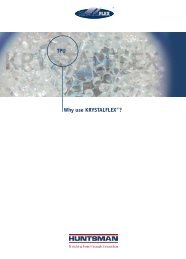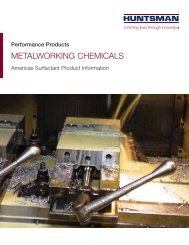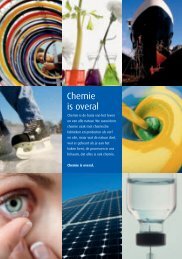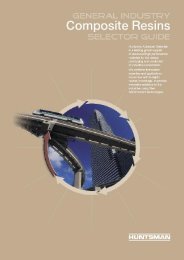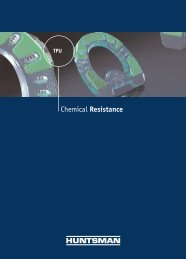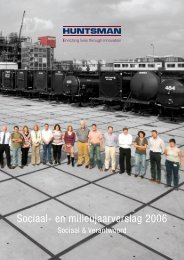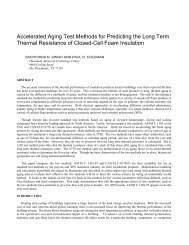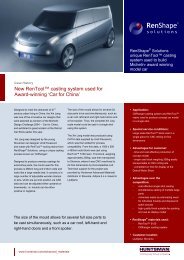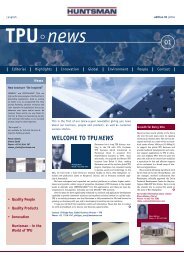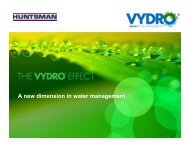New Developments in Polyisocyanurate Laminate Foam - Huntsman
New Developments in Polyisocyanurate Laminate Foam - Huntsman
New Developments in Polyisocyanurate Laminate Foam - Huntsman
You also want an ePaper? Increase the reach of your titles
YUMPU automatically turns print PDFs into web optimized ePapers that Google loves.
<strong>New</strong> <strong>Developments</strong> <strong>in</strong> <strong>Polyisocyanurate</strong> Lam<strong>in</strong>ate <strong>Foam</strong><br />
Formulation and Process<strong>in</strong>g<br />
SACHCHIDA N. SINGH, SHEILA DUBS AND JERRY PILGRIM<br />
<strong>Huntsman</strong> Advanced Technology Center<br />
8600 Gosl<strong>in</strong>g Road<br />
The Woodlands, TX 77381<br />
ABSTRACT<br />
The high price of energy along with concern about global warm<strong>in</strong>g has made energy efficiency a topic of much<br />
discussion lately. Increas<strong>in</strong>g <strong>in</strong>sulation <strong>in</strong> build<strong>in</strong>gs is a proven, universally acceptable way to improve energy efficiency.<br />
Thus it comes as no surprise that the American Society of Heat<strong>in</strong>g, Refrigerat<strong>in</strong>g and Air-Condition<strong>in</strong>g Eng<strong>in</strong>eers<br />
(ASHRAE) recently <strong>in</strong>creased the m<strong>in</strong>imum required prescriptive R-value for roof and wall <strong>in</strong>sulation levels <strong>in</strong> Standard<br />
90.1 – the national model energy code for commercial build<strong>in</strong>gs. <strong>Polyisocyanurate</strong> (polyiso) lam<strong>in</strong>ate board has been the<br />
most widely used <strong>in</strong>sulation <strong>in</strong> North America for commercial roof<strong>in</strong>g as it has consistently met the structural and fire<br />
requirements of the build<strong>in</strong>g codes at the lowest <strong>in</strong>stalled cost per unit R-value. Innovation and persistent optimization of<br />
the formulation and process<strong>in</strong>g has made this possible for polyiso foam and there is a need to cont<strong>in</strong>ue to do so to reap the<br />
full benefits of the new ASHRAE standards.<br />
This work aims to keep the competitive edge of polyiso by cont<strong>in</strong>u<strong>in</strong>g to look for opportunities to further improve its<br />
performance and cost-effectiveness by <strong>in</strong>corporat<strong>in</strong>g recent material developments while align<strong>in</strong>g it even closer to the<br />
current environmental trends. One such trend has been the use of bio-renewable materials, which has led to widespread<br />
experimentation with vegetable oil based polyols <strong>in</strong> polyurethane formulations. <strong>New</strong> aromatic polyester polyols<br />
<strong>in</strong>corporat<strong>in</strong>g renewable resource content have been <strong>in</strong>troduced by polyol suppliers. The lipophilic nature of the vegetable<br />
oils used to make these aromatic polyester polyols has <strong>in</strong>creased the hydrocarbon solubility. Improved solubility opens a<br />
wider spectrum of hydrocarbons such as pure iso-pentane as a blow<strong>in</strong>g agent and/or iso-butane as a low boil<strong>in</strong>g co-blow<strong>in</strong>g<br />
agent. The average functionality of renewable content polyester polyol is claimed to be higher, as the vegetable oils used<br />
present the possibility of provid<strong>in</strong>g many reactive sites. Higher polyol functionality presents opportunities to reformulate<br />
to improve performance and/or reduce cost.<br />
This study demonstrates that polyiso boards with up to 17 weight % bio-renewable content along with up to 7%<br />
recycled content (or up to 12 weight % bio-renewable content along with up to 10% recycle content) can be made while<br />
meet<strong>in</strong>g the fire and structural property requirements; although the density of the board and/or % isocyanate content of the<br />
formulation will have to be raised. It also appears that use of bio-renewable polyol <strong>in</strong> polyiso foam would lead to a slight<br />
reduction <strong>in</strong> thermal resistance of the board. It has been demonstrated that the use of bio-renewable polyols can lead to<br />
more robust process<strong>in</strong>g, especially expand<strong>in</strong>g the process<strong>in</strong>g w<strong>in</strong>dow to higher temperatures. Bio-renewable polyols will<br />
expand the versatility of polyurethane chemistry and the breadth of its applications<br />
INTRODUCTION<br />
A variety of factors, from the high price of energy, to concern about global warm<strong>in</strong>g and deplet<strong>in</strong>g petrochemical<br />
resources, have put the spotlight on energy conservation <strong>in</strong> a build environment. After all, the build<strong>in</strong>g environment<br />
represents a substantial share of global energy consumption and greenhouse gas emissions (GHGs). In the U.S., the<br />
build<strong>in</strong>g environment is responsible for an estimated 42 percent of total energy use, 71 percent of electricity consumption<br />
and 48 percent of all GHGs [1]. Energy lost through roofs, walls and w<strong>in</strong>dows is the s<strong>in</strong>gle largest waste of energy <strong>in</strong>
most build<strong>in</strong>gs. For this reason the American Society of Heat<strong>in</strong>g, Refrigerat<strong>in</strong>g and Air-Condition<strong>in</strong>g Eng<strong>in</strong>eers<br />
(ASHRAE) recently <strong>in</strong>creased the m<strong>in</strong>imum required prescriptive R-value by an average of 30% for roof and wall<br />
<strong>in</strong>sulation levels <strong>in</strong> Standard 90.1 – the national model energy code for commercial build<strong>in</strong>gs. With the highest R-value<br />
per <strong>in</strong>ch of all commercially available <strong>in</strong>sulation board products, polyisocyanurate (polyiso) lam<strong>in</strong>ate boards have been the<br />
<strong>in</strong>sulation of choice for low slope roof<strong>in</strong>g <strong>in</strong> commercial build<strong>in</strong>g even before this <strong>in</strong>crease <strong>in</strong> m<strong>in</strong>imum R-value<br />
requirements. In 2007, polyiso accounted for 67% of all <strong>in</strong>sulation used <strong>in</strong> new roof construction, and 60% of all<br />
<strong>in</strong>sulation used <strong>in</strong> re-roof<strong>in</strong>g on low slope roofs <strong>in</strong> commercial build<strong>in</strong>gs [2]. With the lowest <strong>in</strong>stalled cost <strong>in</strong>sulation per<br />
unit of R-value while meet<strong>in</strong>g the structural and fire requirements of the build<strong>in</strong>g codes and blow<strong>in</strong>g agent mandates of the<br />
Environmental Protection Agency, polyiso <strong>in</strong>sulation is poised to grow to even higher use levels with the proposed<br />
<strong>in</strong>creases <strong>in</strong> the m<strong>in</strong>imum R-value requirements <strong>in</strong> build<strong>in</strong>gs.<br />
The preference for polyiso <strong>in</strong> low slope roof<strong>in</strong>g is attributable to the fact that no other competitive product can match<br />
its comb<strong>in</strong>ation of thermal resistance, fire performance, structural <strong>in</strong>tegrity and cost-effectiveness. The polyiso <strong>in</strong>dustry<br />
has ma<strong>in</strong>ta<strong>in</strong>ed its position of the lowest <strong>in</strong>stalled cost <strong>in</strong>sulation per unit R-value through all recent blow<strong>in</strong>g agent and<br />
other changes by constantly re-exam<strong>in</strong><strong>in</strong>g all the factors that contribute to cost and performance. The <strong>in</strong>dustry needs to<br />
cont<strong>in</strong>ue to look for opportunities to further improve its performance and cost-effectiveness by <strong>in</strong>corporat<strong>in</strong>g recent<br />
material developments and align<strong>in</strong>g it even closer to the current environmental trends. One such trend has been the use of<br />
bio-renewable based materials to replace part, or all of geological or hydrocarbon feedstock based materials. Whether it is<br />
environmental concerns about susta<strong>in</strong>ability, f<strong>in</strong>ancial issues of <strong>in</strong>creas<strong>in</strong>g and volatile petrochemical feedstock prices, or<br />
rat<strong>in</strong>gs <strong>in</strong> environmental audits, there has been an <strong>in</strong>creas<strong>in</strong>g emphasis on the use of bio-renewable materials <strong>in</strong> all<br />
products, not only those us<strong>in</strong>g polyurethane (PU) chemistry.<br />
Products from bio-renewable resources have always played an important role <strong>in</strong> polyurethane <strong>in</strong>dustry. Castor oil<br />
based polyols were <strong>in</strong> use <strong>in</strong> the early 1950’s even ahead of the widespread use of petrochemical based polyether polyols.<br />
For decades, bio-renewable resources such as sugars and starches have been the primary source of <strong>in</strong>itiators for rigid PU<br />
polyols and natural oils have been the source for res<strong>in</strong>s <strong>in</strong> PU pa<strong>in</strong>ts and coat<strong>in</strong>gs. This is primarily because of their better<br />
cost performance balance as compared to synthetic alternatives.<br />
Polyols derived from vegetable oils such as soybean, castor, palm, l<strong>in</strong>seed and so on, along with animal oils and fats<br />
have been the topic of research and <strong>in</strong> many cases commercial production at various times <strong>in</strong> the past. This has generally<br />
been driven by local availability, such as soybean oil <strong>in</strong> the US, palm oil <strong>in</strong> Malaysia, castor oil <strong>in</strong> India, fish oil <strong>in</strong> Iceland<br />
and so on. Lign<strong>in</strong>, the second most abundant component of wood after cellulose, has also been a significant topic of<br />
research and some commercial products to make polyols. Agricultural wastes such as corncob, straw and so on have also<br />
been looked at as source for furfural, which can be converted to tetrahydrofuran (THF) and polyTHF polyol. Over the last<br />
couple of years, the pace of patents, publications and press releases related to bio-renewable materials <strong>in</strong> PU products has<br />
<strong>in</strong>creased substantially.<br />
.<br />
Despite the historic and recent frantic activity, the market share of the bio-renewable resource based products <strong>in</strong> the<br />
total PU materials is still only a few percent. Lack of consistency due to expected seasonal and local variations along with<br />
odor have been l<strong>in</strong>ked to lack of wider market acceptability. It appears that recent process <strong>in</strong>novations and better quality<br />
control has reduced the consistency and odor issues. The primary determ<strong>in</strong>ant for success or lack thereof for biorenewable<br />
products <strong>in</strong> the PU marketplace now is the classical cost versus performance balance. Environmental<br />
recognition associated with bio-renewable products will play some role too.<br />
The objective of this paper is to critically exam<strong>in</strong>e the commercially available bio-renewable products, select the most<br />
viable candidates likely to meet all the performance requirements of the polyiso board for use <strong>in</strong> low slope roof<strong>in</strong>g<br />
application and evaluate them us<strong>in</strong>g a formulation optimized for each of the chosen bio-renewable product. This is done<br />
with the aim of f<strong>in</strong>d<strong>in</strong>g the most cost-effective approach to manufacture board while maximiz<strong>in</strong>g its environmental<br />
credentials.<br />
Environmental credentials<br />
Though there are many different environmental recognition/rat<strong>in</strong>g systems, those <strong>in</strong>volved <strong>in</strong> build<strong>in</strong>g design and<br />
construction generally acknowledge the U. S. Green Build<strong>in</strong>g Council’s (USGBC’s) Leadership <strong>in</strong> Energy and<br />
Environmental Design (LEED) Rat<strong>in</strong>g System as the prom<strong>in</strong>ent bench-mark for build<strong>in</strong>gs[3]. A build<strong>in</strong>g design must<br />
meet certa<strong>in</strong> mandatory requirements and must achieve a m<strong>in</strong>imum number of po<strong>in</strong>ts to atta<strong>in</strong> various levels of LEED<br />
certification. Though a discussion of the LEED Rat<strong>in</strong>g System is outside the scope of this paper, “recycled content,”<br />
“rapidly renewable materials” and “m<strong>in</strong>imum energy performance” are three attributes of the polyiso <strong>in</strong>sulation board used<br />
<strong>in</strong> the roof system of the build<strong>in</strong>g that would be relevant while assess<strong>in</strong>g its rat<strong>in</strong>g [3]. Though LEED is the most<br />
recognized green build<strong>in</strong>g rat<strong>in</strong>g system, some of the alternatives are the Green Globes system sponsored by the Green
Build<strong>in</strong>g Initiatives, and Energy Star for Build<strong>in</strong>gs and Plants by U. S. Environmental Protection Agency. Both give<br />
great importance to energy performance of the build<strong>in</strong>g, but recognition of renewable or recyclable contents are less clearly<br />
def<strong>in</strong>ed.<br />
Besides the environmental rat<strong>in</strong>gs, use of bio-renewable content products are <strong>in</strong>creas<strong>in</strong>gly be<strong>in</strong>g favored <strong>in</strong> U. S.<br />
government federal purchase considerations. As an example, the Farm Security and Rural Investment Act of 2002, section<br />
9002 (7 U.S.C. 8102) requires federal agencies to purchase biobased products, if available, for all items cost<strong>in</strong>g over<br />
$10,000. The United States Department of Agriculture has developed a Biopreferred SM Biobased Product Catalog<br />
designated for preferred procurement status <strong>in</strong> the federal procurement process [4].<br />
BIO-RENEWABLE MATERIALS FOR USE IN POLYISO<br />
Of all the components used to make typical polyiso foam boards, polyols and surfactants are the only two where biorenewable<br />
based materials are commercially available. Surfactants constitute a very small fraction, usually < 1% by<br />
weight, of the total foam formulation and thus any full or partial substitution will not br<strong>in</strong>g forth much environmental<br />
benefits. Thus we focused this study on bio-renewable polyols. The polyol currently used <strong>in</strong> typical polyiso board is<br />
almost exclusively aromatic polyester polyol. As detailed <strong>in</strong> Reference 5, high aromatic content is required <strong>in</strong> polyiso<br />
foam board <strong>in</strong> order to meet the very demand<strong>in</strong>g, build<strong>in</strong>g code mandated large scale fire tests while meet<strong>in</strong>g the structural<br />
and thermal <strong>in</strong>sulation properties, all at a cost-competitive density. It is important to remember that polyiso roof <strong>in</strong>sulation<br />
is known for be<strong>in</strong>g the only foam plastic board product that meets the strict standards of both Factory Mutual (FM)<br />
Approvals (Standard 4450) for Class 1 roof systems and for Underwriters Laboratories (UL) 1256 without the use of an<br />
additional thermal barrier layer between the <strong>in</strong>sulation and the support<strong>in</strong>g steel deck. As such, any re-formulation us<strong>in</strong>g<br />
bio-renewable polyol must reta<strong>in</strong> this quality.<br />
A review of literature suggests that lign<strong>in</strong> is about the only bio-renewable source with reasonable aromatic content.<br />
Lign<strong>in</strong>, a by-product of the pulp and paper <strong>in</strong>dustry, is abundant and conta<strong>in</strong>s active hydrogen groups but it is a highly<br />
cross-l<strong>in</strong>ked, high molecular weight material. Despite extensive research, no commercial product exists which is amenable<br />
to polyiso production, i.e., liquid at 25-40 o C without use of solvents. Natural oils, derived from either plants or animal<br />
sources, are fatty acid triglycerides and do not conta<strong>in</strong> aromatic groups. A review of polyurethane foam literature and<br />
prelim<strong>in</strong>ary work us<strong>in</strong>g hand mix foam suggested that it would not be possible to meet the above referenced fire<br />
requirements us<strong>in</strong>g natural oil based polyols alone. Either a physical mixture with exist<strong>in</strong>g aromatic polyester polyols or<br />
some modification of the natural oil based material with aromatic conta<strong>in</strong><strong>in</strong>g materials would be necessary. The fatty acid<br />
component of the natural oil does present the potential to <strong>in</strong>crease solubility of the pentanes, which is the blow<strong>in</strong>g agent of<br />
choice <strong>in</strong> the polyiso <strong>in</strong>dustry.<br />
Given the wide array of natural oils available (soybean, castor, corn, palm, sunflower, l<strong>in</strong>seed, tallow, lard, fish etc.),<br />
the question is, which natural oil based product is best suited for use <strong>in</strong> polyiso foam board <strong>in</strong> North America. All natural<br />
oils are fatty acid triglycerides with a wide distribution of triglyceride structures. Most fatty acid triglycerides, with the<br />
exceptions of castor oil and rare lesquerella oil, do not conta<strong>in</strong> active hydrogen groups capable of reaction with<br />
isocyanates. Though unmodified and modified (alkoxylated or transesterified) castor oils have been used <strong>in</strong> rigid foam,<br />
their availability <strong>in</strong> North America is restricted due to their geographically limited area of cultivation - primarily India and<br />
Brazil. Fatty acid triglycerides from all other sources need to be functionalized to make them reactive with isocyanates.<br />
The preferred natural oils used <strong>in</strong> North America are soybean oils and l<strong>in</strong>seed oils because of their availability and high<br />
content of triglycerides of unsaturated fatty acids such as oleic, l<strong>in</strong>oleic and l<strong>in</strong>olenic acids and lesser contents of<br />
triglycerides of saturated fatty acids such as palmitic and stearic acids (see Figure 1 and 2). The unsaturated fatty acids can<br />
be functionalized much more easily than the saturated ones.<br />
Keep<strong>in</strong>g above <strong>in</strong> m<strong>in</strong>d, we chose the follow<strong>in</strong>g four sets of commercially available polyols for evaluation <strong>in</strong> this study:<br />
(a) Ecopol 123 and Ecopol 124 polyols from ECOPUR USA: They are aromatic polyester polyol based on soy oil<br />
grafted with recycled polyethylene terephthalate (PET). As seen <strong>in</strong> Table 1, the hydroxyl (OH) number, viscosity etc. of<br />
Ecopol 123 polyol is very similar to polyols currently used by the US polyiso <strong>in</strong>dustry, exemplified here by STEPANPOL ®<br />
PS-2352 polyol. Ecopol 123 polyol is claimed to have a bio-renewable content of 40% and a post-consumer recycle<br />
content of 35%. As seen from Table 1, the pentane solubility <strong>in</strong> Ecopol 123 polyol is significantly higher than that <strong>in</strong><br />
STEPANPOL l ® PS-2352 polyol. The OH number of Ecopol 124 polyol is similar to the recently <strong>in</strong>troduced low OH<br />
polyols, exemplified <strong>in</strong> Table 1 TEROL ® 1154 polyol. Renewable content of Ecopol 124 polyol is even higher, 60% and<br />
so is the pentane solubility. Higher pentane solubility and higher claimed functionality of the Ecopol polyols is likely to<br />
be attributable to the fact that it is made through a biolipid transesterification, similar to production of biodiesel, us<strong>in</strong>g<br />
PET, soybean oil polyol and glycol [6].
(b) TEROL® 1154 from OXID L.P.: Introduced <strong>in</strong> 2006 as the low hydroxyl number polyester polyol for the<br />
lam<strong>in</strong>ation <strong>in</strong>dustry with higher functionality TEROL® 1154 is claimed to conta<strong>in</strong> bio-renewable resource content of 20%<br />
and pre-consumer recycle content of 24% [7]. Solubility of pentane <strong>in</strong> TEROL® 1154 is higher than polyols currently<br />
used by the US polyiso <strong>in</strong>dustry, but it is not as high as those <strong>in</strong> Ecopol 123 and Ecopol 124 polyols.<br />
Figure 1. Schematic representation of fatty acid triglyceride conta<strong>in</strong><strong>in</strong>g one each of oleic, l<strong>in</strong>oleic and l<strong>in</strong>olenic structure<br />
(c) AGROL® Diamond polyol from BioBased ® Technologies: Introduced as a research and development material<br />
earlier this year, it is a soy-based polyol with bio-renewable content of 86%. It has a functionality of 3, hydroxyl number<br />
of 360, both significantly higher than current polyols used to make polyiso boards. Though pentane solubility <strong>in</strong> this polyol<br />
is high, it does not conta<strong>in</strong> any aromatic groups. Thus it was evaluated as a physical blend with STEPANPOL ® PS-2352<br />
an aromatic polyester polyol.<br />
Lard<br />
Palm<br />
Corn<br />
L<strong>in</strong>seed<br />
Soybean<br />
Sun flower<br />
Canola<br />
0% 20% 40% 60% 80% 100%<br />
Palmitic C16:0 Stearic C18:0 Oleic C18:1 L<strong>in</strong>oleic C18:2 L<strong>in</strong>olenic C18:3<br />
Figure 2. Typical esterified fatty acid content for various natural oils
(d) JEFFOL ® SG-360 polyol from <strong>Huntsman</strong>: A sucrose and glycer<strong>in</strong> co-<strong>in</strong>itiated polypropylene oxide extended<br />
polyether polyol which represents bio-renewable content polyol <strong>in</strong> use by the polyurethane <strong>in</strong>dustry for decades. The biorenewable<br />
content of this polyol is significantly lower, 24%, compared to AGROL ® Diamond polyol, but its functionality<br />
and hydroxyl number is high and it too does not conta<strong>in</strong> any aromatic groups. Thus, it was evaluated as a physical blend<br />
with STEPANPOL ® PS-2352, an aromatic polyester polyol.<br />
Table 1. Characteristics of polyols used <strong>in</strong> this study<br />
STEPANPOL ®<br />
TEROL<br />
PS-2352<br />
®<br />
Ecopol 123 Ecopol 124 AGROL<br />
1154<br />
®<br />
JEFFOL<br />
Diamond<br />
®<br />
SG360<br />
OH No., mg KOH/g 240 200 240 195 350 360<br />
Acid No., mg KOH/g 0.6 – 1.0 0.5 - 1.5
JEFFCAT ® ZF-20 catalyst used a 4:1 weight ratio of Pel-Cat 9540-A with JEFFCAT ® ZF-20 catalyst and does not show a<br />
dist<strong>in</strong>ct 2 nd rise. The catalyst package conta<strong>in</strong><strong>in</strong>g JEFFCAT ® ZF-20 catalyst was used <strong>in</strong> all subsequent formulations<br />
conta<strong>in</strong><strong>in</strong>g Ecopol 123 polyol.<br />
The selection of silicone surfactant <strong>in</strong>volved screen<strong>in</strong>g different surfactants for giv<strong>in</strong>g the most uniform, defect-free,<br />
dom<strong>in</strong>antly closed cell, f<strong>in</strong>e cellular structure and good pentane emulsion stability. With the exception of formulations<br />
us<strong>in</strong>g Ecopol124 polyol, the others formed an emulsion with sufficient pentane to yield a foam density of 1.75 pcf. Most<br />
of the surfactant screen<strong>in</strong>g work was performed by Evonik Goldschmidt Corporation us<strong>in</strong>g their commercial and<br />
experimental surfactant.<br />
Rate of rise,, mm/sec<br />
12<br />
10<br />
Board Mak<strong>in</strong>g and Test<strong>in</strong>g<br />
8<br />
6<br />
4<br />
2<br />
0<br />
0 10 20 30 40 50 60<br />
Time, seconds<br />
JEFFCAT® ZF-20 JEFFCAT® PMDETA<br />
Figure 3. Rate of rise profile for two separate catalyst packages <strong>in</strong> a formulation<br />
us<strong>in</strong>g Ecopol 123 polyol<br />
Lam<strong>in</strong>ate boards us<strong>in</strong>g optimized formulations for each polyol were made us<strong>in</strong>g an Edge Sweets high pressure foam<br />
mach<strong>in</strong>e and a 12.5” wide, 4” deep and 36” long mold. The mold sat on a conveyor which moved when the foam was<br />
poured <strong>in</strong>to it. The conveyor speed was adjusted so that a “just fill” foam board with cell orientation typical of a<br />
commercial lam<strong>in</strong>ation l<strong>in</strong>e was obta<strong>in</strong>ed. Unless stated otherwise, the follow<strong>in</strong>g conditions were used to make all<br />
lam<strong>in</strong>ates:<br />
Chemical throughput = 23 lb/m<strong>in</strong>.<br />
Mix pressure = 2000 psi<br />
Chemical temperature at mix-head = 80 - 85 o F<br />
Mold temperature = 140 o F<br />
Demold time = 8 m<strong>in</strong>utes<br />
The amount of pentane <strong>in</strong> the formulation was selected such as to yield the desired defaced board density (density of<br />
board with facer shaved off, henceforth referred to as overall density). All lam<strong>in</strong>ate boards were tested for density (ASTM<br />
D1622); thermal conductivity (ASTM C518); Long Term Thermal Resistance, LTTR (ASTM C1289, Annex A, 10 mm<br />
slice thickness); compressive strength (ASTM D1621, Procedure A); dimensional stability (ASTM D2126, 7 days at -<br />
40 o F/amb%RH us<strong>in</strong>g 10” x 10” x full thickness lam<strong>in</strong>ate and 70 o C/97%RH us<strong>in</strong>g 4” x 4” x 1” core foam); tumbl<strong>in</strong>g<br />
friability (ASTM C421); PIR/PUR ratio [9]; Butler Chimney (ASTM D3014); Smoke Density (ASTM E662); oxygen<br />
<strong>in</strong>dex (ASTM) and hot plate.<br />
S<strong>in</strong>ce the foam polymer matrix be<strong>in</strong>g evaluated here is of a new type, the dimensional stability was also tested under<br />
the Dimvac test condition on the core foam at -40 o F. Our prior work has demonstrated that Dimvac test conditions<br />
simulate the most severe field exposure [10].
RESULTS AND DISCUSSIONS<br />
As seen <strong>in</strong> Tables 2-4, the closed cell content of all foam boards produced <strong>in</strong> this study is high, >86% uncorrected, and<br />
the cell size is <strong>in</strong> the range of 200-300 micron. Such numbers are typical of commercially produced polyiso boards and<br />
validate our aim to evaluate each polyol for its true attributes us<strong>in</strong>g the formulation that is optimal for the given polyol or<br />
polyol blend.<br />
The properties of boards made with STEPANPOL ® PS-2352 polyol at the overall foam density of 1.75 pcf are deemed<br />
as reference <strong>in</strong> this study. As seen <strong>in</strong> Table 2, properties of boards made us<strong>in</strong>g STEPANPOL ® PS-2352 polyol are good<br />
and suggest that full size boards manufactured us<strong>in</strong>g this formulation at the 1.75 pcf overall density will meet the current<br />
model build<strong>in</strong>g code requirements [5].<br />
Ecopol 123 and Ecopol 124<br />
Table 2 shows the formulations and properties of all boards made us<strong>in</strong>g these two polyols, along with those made us<strong>in</strong>g<br />
STEPANPOL ® PS-2352 polyol. All boards made at an overall density of 1.75 pcf are marked “Ref. Dens.” (listed just<br />
below the head<strong>in</strong>g of the Table) whereas those made at a higher density are marked “High Dens.” The laydown with both<br />
Ecopol polyols was essentially “solution or liquid” much like that with HCFC-141b and very different than “f<strong>in</strong>e<br />
emulsion” seen with STEPANPOL® PS-2352 polyol us<strong>in</strong>g blends of iso-pentane and n-pentane. Process<strong>in</strong>g temperature<br />
w<strong>in</strong>dow with either Ecopol polyol was much higher as compared to that with STEPANPOL® PS-2352 polyol., i.e., there<br />
was no rapid froth<strong>in</strong>g even when mix-head chemical temperature was high. We noticed that the total blow<strong>in</strong>g level<br />
required to get to a given overall board density was about 7.5% higher for Ecopol 124 polyol than those for either<br />
STEPANPOL® PS-2352 polyol or Ecopol 123 polyol.<br />
Compar<strong>in</strong>g properties of boards made with Ecopol 123 polyol at 1.75 pcf overall density with that of STEPANPOL ®<br />
PS-2352 polyol, we can see that Ecopol 123 polyol board exhibits equivalent, if not slightly better, fire performance but the<br />
thermal resistance and structural properties, <strong>in</strong> particular compressive strength and low temperature dimensional stability,<br />
are poorer. The lower compressive strength value across the thickness for the lam<strong>in</strong>ate and of the geometric mean for the<br />
core foam, as well as shr<strong>in</strong>kage under low temperature dimensional stability test conditions, as illustrated <strong>in</strong> Figure 3,<br />
suggest that Ecopol 123 polyol based foam is weaker. The geometric mean compressive strength (MCS) of the core foam,<br />
def<strong>in</strong>ed as the geometric mean of the compressive strength measured <strong>in</strong> each of the three pr<strong>in</strong>cipal axes of the foam (rise,<br />
mach<strong>in</strong>e and cross-mach<strong>in</strong>e directions) is an <strong>in</strong>dicator of polymer strength of the foam, without the vagaries of cell<br />
orientation. The follow<strong>in</strong>g relationship between MCS and core foam density has been observed historically for closed cell<br />
polyurethane foam and was found to hold for foams made <strong>in</strong> this study [9].<br />
MCS = Material Constant x Density 1.61 (1)<br />
The value of the “Material Constant” rema<strong>in</strong>s the same as long as density is changed by vary<strong>in</strong>g the amount of blow<strong>in</strong>g<br />
agent while keep<strong>in</strong>g the formulation and process<strong>in</strong>g essentially the same. This relationship was used to calculate the core<br />
foam density at which the MCS of board made us<strong>in</strong>g Ecopol 123 polyol would equal that for the reference. <strong>Foam</strong> was<br />
made target<strong>in</strong>g the calculated density and is identified as “High Dens” <strong>in</strong> Table 2. We can see that the structural properties<br />
of the Ecopol 123 foam at about 7% higher density are similar or better than the reference foam. The fire properties at this<br />
higher density are, if anyth<strong>in</strong>g, better than the reference.<br />
Friability of foams made with Ecopol 123 polyol is higher than that for the reference but the facer adhesion, though not<br />
experimentally measured, appeared to be extremely good.. The thermal resistance, both <strong>in</strong>itial and more importantly,<br />
LTTR, of the Ecopol 123 foam is lower than that for reference even at the higher density. We did not <strong>in</strong>vestigate the<br />
underly<strong>in</strong>g reasons for this but cell size numbers suggest that it is unlikely to be cell size related.<br />
<strong>Foam</strong> boards made with Ecopol 124 polyol followed essentially the same trend as that with Ecopol 123 polyol. The<br />
significantly higher PIR/PUR ratio and friability with Ecopol 124 is likely to be the result of much higher <strong>in</strong>dex associated<br />
with lower hydroxyl number of the Ecopol 124 as we kept the % isocyanate the same <strong>in</strong> all the foams compared <strong>in</strong> Table 2.<br />
PIR/PUR ratio is just a diagnostic tool and a higher number is generally desirable. Despite the high tumbl<strong>in</strong>g friability, the<br />
facer adhesion did not appear to be an issue with Ecopol 124. Though we did not experimentally measure facer peel<br />
adhesion, there was no visual appearance of foam-facer delam<strong>in</strong>ation and facer generally tore off rather than delam<strong>in</strong>ate<br />
when manually pull<strong>in</strong>g us<strong>in</strong>g a f<strong>in</strong>ger-nail.
Table 2: Formulations and Properties of foam boards made us<strong>in</strong>g STEPANPOL® PS-2352, Ecopol 123 and Ecopol 124<br />
STEPANPOL ®<br />
PS-2352<br />
Ecopol 123 Ecopol 124<br />
Formulation, % total system REFERENCE Ref. Dens. High Dens. Ref. Dens. High Dens.<br />
STEPANPOL ® PS-2352 polyol 29.50<br />
Ecopol 123 polyol 28.93 29.59<br />
Ecopol 124 polyol 27.59 28.22<br />
TCPP 4.33 4.33 4.33 4.33 4.33<br />
K-octoate (15% K) 1.05 1.43 1.43 1.91 1.91<br />
JEFFCAT ® PMDETA catalyst 0.21<br />
JEFFCAT ® JF-20 catalyst 0.36 0.36 0.61 0.61<br />
Silicone surfactant 1 0.58 0.58 0.58<br />
Silicone surfactant 2 0.58 0.58<br />
Water 0.11 0.11 0.11 0.12 0.11<br />
Iso-pentane 2.47 2.47 2.28 2.66 2.48<br />
n-Pentane 5.77 5.77 5.32 6.20 5.78<br />
RUBINATE ® 1850 isocyanate 56 56 56 56 56<br />
Index 282 275 270 323 319<br />
Total Blow<strong>in</strong>g , mL/g 27 27 25 29 27<br />
Bio-renewable Content, % NA 11.6 11.8 16.6 16.9<br />
Recycle content, % NA 10.1 10.4 6.9 7.1<br />
Physical Properties<br />
Core foam density, pcf 1.68 1.70 1.82 1.70 1.90<br />
Defaced lam<strong>in</strong>ate density, pcf 1.75 1.75 1.87 1.75 1.96<br />
Uncorrected closed cell content, % 88 89 88 88 87<br />
Isotropic cell size, micron 255 225 260 250 270<br />
Compressive Strength, psi<br />
Lam<strong>in</strong>ate, across thickness 15.9 14.4 16.1 14.3 17.4<br />
Core, geometric mean 15.5 13.8 15.4 13.3 16.0<br />
Dimensional stability, Lam<strong>in</strong>ate<br />
2 weeks @ -40 o F, Rank* 1-4 1 3 1 2 1<br />
Dim. Stab., core foam, % l<strong>in</strong>ear change<br />
1 wks @ -40 o F after Dimvac -0.1 -3.1 -0.4 2.8 -0.3<br />
2 wks @ 158 o F/97%RH 2.7 0.9 0.5 0.7 0<br />
Friability, % 6 15 10 30 33<br />
Thermal Resistance, ft 2 .h. o F/Btu.<strong>in</strong><br />
Initial, 6.3 5.9 6.1 5.8 5.9<br />
Predicted LTTR for 4” 5.7 5.3 5.4 5.2 5.3<br />
Fire Performance<br />
PIR/PUR ratio 2.4 2.5 2.4 4.0 4.1<br />
Hot Plate weight retention, % 89 90 91 89 91<br />
Hot Plate thickness retention, % 89 91 90 91 93<br />
Butler Chimney<br />
Weight retention, % 81 83 84 75 88<br />
Ext<strong>in</strong>guish time, sec. 11 11 11 15 12<br />
Oxygen Index 23.8 23.8 23.8 23.8 24.4<br />
NBS max. smoke density 34 37 46 35 37<br />
Rank* 1 - No distortion, 2 - Some edge collapse, 3- Severe edge collapse, 4 – Severe distortion
The Butler Chimney performance of Ecopol 124 at 1.75 pcf overall density appears to be slightly <strong>in</strong>ferior than the<br />
reference or Ecopol 123, but is unlikely to be an issue given that roof<strong>in</strong>g boards have to meet only class II flame spread<br />
requirement <strong>in</strong> ASTM E-84 test for approvals <strong>in</strong> most, if not all, build<strong>in</strong>g codes. The structural and thermal resistance<br />
properties of boards made with Ecopol 124 polyol are poorer than reference and statistically about equivalent to those with<br />
Ecopol 123 polyol. “High Dens” Boards were made us<strong>in</strong>g Ecopol 124 polyol with a target of the overall density of 1.87<br />
pcf calculated us<strong>in</strong>g Equation 1. The actual density of the board was actually 1.96 pcf which would expla<strong>in</strong> why the<br />
result<strong>in</strong>g structural and fire properties were better than the reference too. Surpris<strong>in</strong>gly, the predicted long term thermal<br />
resistance of the board that is over 12% higher <strong>in</strong> density was still only 5.3 ft 2 .h. o F/Btu.<strong>in</strong>. This along with other aspects of<br />
results on the Ecopol 123 and Ecopol 124 polyols are discussed <strong>in</strong> the “overall f<strong>in</strong>d<strong>in</strong>gs” section after we have looked at<br />
results on rema<strong>in</strong><strong>in</strong>g polyols.<br />
Figure 3. Pictures of 10” by 10” x full thickness lam<strong>in</strong>ate after a week at -40 o F. STEPANPOL® PS-2352 polyol represents the<br />
reference whereas Ecopol 123, TEROL ® 1154, AGROL ® Diamond and JEFFOL ® SG-360 polyols represent boards us<strong>in</strong>g the named<br />
polyol at the overall density of 1.75 pcf.<br />
TEROL ® 1154 polyol<br />
Table 3 shows the formulations and properties of boards made us<strong>in</strong>g TEROL ® 1154 polyol. The laydown when us<strong>in</strong>g<br />
TEROL ® 1154 polyol was a “coarse emulsion” even after the amount of surfactant was <strong>in</strong>creased to 0.88% compared to<br />
the nom<strong>in</strong>al of 0.58 wt % <strong>in</strong> the total system. This is surpris<strong>in</strong>g given the higher pentane solubility <strong>in</strong> TEROL ® 1154<br />
polyol. Process<strong>in</strong>g temperature w<strong>in</strong>dow with this polyol was, if anyth<strong>in</strong>g, lower as compared to that with reference. It<br />
appears that TEROL ® 1154 polyol is not well suited for use with iso-pentane rich blend.<br />
The properties of boards made at 1.75 pcf density with TEROL ® 1154 polyol were not as good as those for reference <strong>in</strong><br />
structural, thermal resistance and fire properties. The structural properties are best illustrated <strong>in</strong> Figure 3 which shows that<br />
the board us<strong>in</strong>g TEROL ® 1154 polyol shows some edge collapse whereas the reference shows no distortion after exposure<br />
to 1 week at -40 o F. When the density was raised by target<strong>in</strong>g a level where MCS of the board made us<strong>in</strong>g TEROL ® 1154<br />
polyol would equal that of the reference calculated us<strong>in</strong>g equation (1), the structural and fire properties were comparable to<br />
those of the reference. Thermal resistance of TEROL ® 1154 board even at this density, about 4% higher, was a bit poorer.<br />
Though tumbl<strong>in</strong>g friability values for TEROL ® 1154 foams were higher than reference, facer adhesion was good <strong>in</strong> all<br />
cases.<br />
AGROL ® Diamond polyol<br />
Formulations and properties of boards made conta<strong>in</strong><strong>in</strong>g AGROL ® Diamond polyol are shown <strong>in</strong> Table 3. As discussed<br />
earlier, s<strong>in</strong>ce it does not have any aromatic content, we evaluated a 33:67 weight ratio physical blend of AGROL ®<br />
Diamond polyol to STEPANPOL ® PS-2352 polyol. The polyol blend made us<strong>in</strong>g this specific blend of polyol was not<br />
completely miscible and had to be kept cont<strong>in</strong>uously agitated to keep it homogeneous. The lay down with this polyol<br />
blend was a “f<strong>in</strong>e emulsion” similar to those seen with STEPANPOL ® PS-2352 polyol. Blend<strong>in</strong>g AGROL ® Diamond<br />
polyol with STEPANPOL ® PS-2352 polyol did <strong>in</strong>crease the chemical temperature up to which it could be processed<br />
without rapid froth<strong>in</strong>g. Total blow<strong>in</strong>g level required to get to a given overall board density was about 5% higher for the<br />
polyol blend used here than for the reference.
Table 3: Formulations and Properties of foam boards made us<strong>in</strong>g TEROL® 1154 and AGROL® Diamond<br />
STEPANPOL ®<br />
PS-2352<br />
TEROL ® 1154 AGROL ® Diamond<br />
Formulation, % total system REFERENCE Ref. Dens. High Dens. Ref. Dens. High Iso High FR<br />
STEPANPOL ® PS-2352 polyol 29.50 19.34 16.47 18.65<br />
TEROL ® 1154 polyol 27.84 28.05<br />
AGROL ® Diamond polyol 9.52 8.11 9.18<br />
TCPP 4.33 4.33 4.33 4.33 4.33 5.63<br />
K-octoate (15% K) 1.05 2.04 2.04 1.21 1.21 1.21<br />
K-acetate (10% K) 0.49 0.49<br />
JEFFCAT ® PMDETA catalyst 0.21 0.07 0.07 0.24 0.24 0.24<br />
Silicone surfactant 1 0.58<br />
Silicone surfactant 2 0.88 0.88 0.58 0.87 0.58<br />
Water 0.11 0.11 0.11 0.12 0.12 0.11<br />
Iso-pentane 2.47 2.47 2.41 2.60 2.60 2.52<br />
n-Pentane 5.77 5.77 5.62 6.06 6.06 5.87<br />
RUBINATE ® 1850 isocyanate 56 56 56 56 60 56<br />
Index 282 299 298 249 305 257<br />
Total Blow<strong>in</strong>g , mL/g 27 27 26.3 28.4 28.4 27.5<br />
Bio-renewable Content, % NA 5.6 5.6 8.2 7 7.9<br />
Recycle content, % NA 6.7 6.7 0 0 0<br />
Physical Properties<br />
Core foam density, pcf 1.68 1.70 1.78 1.69 1.72 1.74<br />
Defaced lam<strong>in</strong>ate density, pcf 1.75 1.75 1.82 1.75 1.77 1.81<br />
Uncorrected closed cell content, % 88 88 88 86 86 87<br />
Isotropic cell size, micron 255 260 250 280 268 270<br />
Compressive Strength, psi<br />
Lam<strong>in</strong>ate, across thickness 15.9 14.5 16 16.9 18.7 14.7<br />
Core, geometric mean 15.5 14 15.3 13.1 16.9 13.6<br />
Dimensional stability, Lam<strong>in</strong>ate<br />
2 weeks @ -40 o F, Rank* 1-4 1 2 1 3 1 3<br />
Dim. Stab., core foam, % l<strong>in</strong> change<br />
1 wks @ -40 o F after Dimvac -0.1 -1.4 -0.2 -5.1 -1.5 -4.4<br />
2 wks @ 158 o F/97%RH 2.7 2.5 2.3 4 2.2 3.7<br />
Friability, % 5.8 8.6 10.8 8.6 20.7 9<br />
Thermal Resistance, ft 2 .h. o F/Btu.<strong>in</strong><br />
Initial, 6.3 6.0 6.1 5.8 5.9 6.0<br />
Predicted LTTR for 4” 5.7 5.5 5.5 5.3 5.4 5.4<br />
Fire Performance<br />
PIR/PUR ratio 2.4 2.6 2.6 2.2 3.1 2.4<br />
Hot Plate weight retention, % 89 86 88 85 89 86<br />
Hot Plate thickness retention, % 89 80 88 80 90 84<br />
Butler Chimney<br />
Weight retention, % 81 75 83 57 75 82<br />
Ext<strong>in</strong>guish time, sec. 11 14 12 20 15 13<br />
Oxygen Index 23.8 23.8 23.8 22.6 23.6 23.8<br />
NBS max. smoke density 34 45 50 96 42 51<br />
Rank* 1 - No distortion, 2 - Some edge collapse, 3- Severe edge collapse, 4 – Severe distortion
As can be seen by compar<strong>in</strong>g the properties of 1.75 pcf overall density board made us<strong>in</strong>g AGROL ® Diamond blended<br />
polyol with that of the reference, addition of AGROL ® Diamond polyol to STEPANPOL ® PS-2352 polyol deteriorates its<br />
structural, thermal resistance and fire properties. Figure 3 illustrates the loss <strong>in</strong> structural properties, show<strong>in</strong>g that the<br />
board conta<strong>in</strong><strong>in</strong>g AGROL ® Diamond polyol has severe edge collapse whereas neat STEPANPOL ® PS-2352 polyol board<br />
has no distortion after exposure to 1 week at -40 o F. The loss <strong>in</strong> fire properties is large, reduc<strong>in</strong>g the Hot Plate thickness<br />
retention and Butler Chimney weight retention to a po<strong>in</strong>t where the board may not pass the regulatory fire codes.<br />
Though it is likely that a significant <strong>in</strong>crease <strong>in</strong> board density could restore the fire and structural properties, we<br />
determ<strong>in</strong>ed that <strong>in</strong>creas<strong>in</strong>g the amount of isocyanate and/or fire retardant would be more economical. Column identified as<br />
“High Iso” <strong>in</strong> Table 3 shows the formulation and properties when the amount of isocyanate is <strong>in</strong>creased from 56% to 60%<br />
of the total foam formulation while the total blow<strong>in</strong>g is kept the same as that for the reference. Indeed, the fire and<br />
structural properties of this “High Iso” board is comparable to that of the reference. Though the overall density for the<br />
blended polyol board on which the properties were measured is about 1% higher, 1.77 pcf, we anticipate that such “High<br />
Iso” board made at 1.75 pcf overall density would still be comparable to reference <strong>in</strong> fire and structural properties.<br />
Tumbl<strong>in</strong>g friability value for this “High Iso” foam is higher than reference but the facer adhesion appeared very good. The<br />
predicted LTTR for this “High Iso” board was still only 5.4 ft 2 .h. o F/Btu.<strong>in</strong>. , ~ 5% lower than the reference.<br />
AGROL ® Diamond blended polyol with about 50% higher TCPP level and at about 3 % higher density was made us<strong>in</strong>g<br />
formulation listed under “High FR” <strong>in</strong> Table 3. Though the fire properties of this board are close to that of the reference<br />
board, the structural properties are still poor. The density of the “High FR” board would have to be <strong>in</strong>creased to even<br />
higher value for it to be dimensionally stable under cold conditions. The predicted LTTR for this “High FR” board was<br />
still <strong>in</strong>ferior as compared to that of the reference.<br />
JEFFOL ® SG360 polyol<br />
Like AGROL® Diamond polyol, JEFFOL ® SG360 polyol does not have any aromatic content, and thus it too was<br />
evaluated as a 33:67 weight ratio physical blend of JEFFOL ® SG360 polyol to STEPANPOL ® PS-2352 polyol. Polyol<br />
blend made us<strong>in</strong>g this ratio of polyol was homogeneous. The lay down with this polyol blend was a “f<strong>in</strong>e emulsion”<br />
similar to those seen with STEPANPOL ® PS-2352 polyol. Blend<strong>in</strong>g JEFFOL ® SG360 polyol to STEPANPOL ® PS-2352<br />
polyol appeared to somewhat raise the chemical temperature up to which it could be processed without rapid froth<strong>in</strong>g, but<br />
the effect is small compared to those obta<strong>in</strong>ed with AGROL ® Diamond polyol.<br />
As seen <strong>in</strong> Table 4, the addition of JEFFOL ® SG-360 polyol to STEPANPOL ® PS-2352 polyol deteriorates its<br />
structural, thermal resistance and fire properties, though the reduction <strong>in</strong> fire properties is relatively small or even<br />
<strong>in</strong>consequential. Butler Chimney predicts the flame spread characteristics of foam and weight retention of 73 % may be<br />
sufficient to meet the ASTM E-84 flame spread requirements mandated <strong>in</strong> build<strong>in</strong>g codes. As can be seen <strong>in</strong> Figure 4, the<br />
edge collapse for JEFFOL ® SG360 polyol conta<strong>in</strong><strong>in</strong>g board is less severe than those with AGROL ® Diamond polyol.<br />
Given these, we anticipated that rais<strong>in</strong>g the density a bit higher, calculated to be about 5% us<strong>in</strong>g Equation (1), could make<br />
the structural and fire properties of JEFFOL ® SG360 polyol equivalent to those of the reference. As seen from Table 4,<br />
that is <strong>in</strong>deed the case.<br />
We opted to evaluate whether rais<strong>in</strong>g the isocyanate level from 56 weight % to 57.5% while keep<strong>in</strong>g the density the<br />
same as the reference would be an alternate way to meet the structural and fire properties. Compar<strong>in</strong>g properties of “High<br />
Iso” board with reference and with “High Dens.” <strong>in</strong> Table 4 <strong>in</strong>dicates that the structural and fire properties with “High Iso”<br />
is comparable to the reference. The predicted LTTR for both “High FR” and “High Iso” board was essentially the same<br />
and lower than that of the reference.<br />
Overall F<strong>in</strong>d<strong>in</strong>gs:<br />
Above data and discussions suggest that the use of bio-renewable polyols <strong>in</strong> polyiso foam offers some benefits but also<br />
br<strong>in</strong>gs forth some challenges. We see the potential to get a liquid laydown, much like those seen with use of HCFC-141b,<br />
with Ecopol 124 polyol while us<strong>in</strong>g the desirable iso-pentane rich pentane blend as a blow<strong>in</strong>g agent. The process<strong>in</strong>g<br />
w<strong>in</strong>dow for use of iso-pentane rich pentane blend as a blow<strong>in</strong>g agent can be extended to a higher temperature us<strong>in</strong>g Ecopol<br />
123 polyol or Ecopol 124 polyol as the sole polyol or AGROL ® Diamond polyol and to a lesser extent JEFFOL ® SG-360<br />
polyol as a co-polyol. It appears that an iso-pentane rich pentane blend is not favored by TEROL ® 1154 polyol.
Table 4: Formulations and Properties of foam boards made us<strong>in</strong>g JEFFOL ® SG-360 polyol<br />
STEPANPOL ®<br />
PS-2352<br />
JEFFOL ® SG-360<br />
Formulation, % total system REFERENCE Ref. Dens. High Dens. High Iso.<br />
STEPANPOL ® PS-2352 polyol 29.50 19.34 19.72 18.35<br />
JEFFOL ® SG-360 polyol 9.52 9.71 9.04<br />
TCPP 4.33 4.33 4.33 4.33<br />
K-octoate (15% K) 1.05 1.18 1.18 1.18<br />
JEFFCAT® PMDETA catalyst 0.21 0.24 0.24 0.24<br />
Silicone surfactant 1 0.58 0.58 0.58 0.58<br />
Water 0.11 0.12 0.11 0.12<br />
Iso-pentane 2.47 2.61 2.43 2.61<br />
n-Pentane 5.77 6.09 5.68 6.09<br />
RUBINATE ® 1850 isocyanate 56 56 56 57.5<br />
Index 282 246 244 265<br />
Total Blow<strong>in</strong>g , mL/g 27 28.5 26.6 28.5<br />
Bio-renewable Content, % NA 2.3 2.3 2.2<br />
Recycle content, % NA 0 0 0<br />
Physical Properties<br />
Core foam density, pcf 1.68 1.70 1.78 1.72<br />
Defaced lam<strong>in</strong>ate density, pcf 1.75 1.75 1.84 1.76<br />
Uncorrected closed cell content, % 88 86 89 88<br />
Isotropic cell size, micron 255 250 265 280<br />
Compressive Strength, psi<br />
Lam<strong>in</strong>ate, across thickness 15.9 14.3 15.6 17<br />
Core, geometric mean 15.5 14 15.2 15.3<br />
Dimensional stability, Lam<strong>in</strong>ate<br />
2 weeks @ -40 o F, Rank* 1-4 1 2 1 1<br />
Dim. Stab., core foam, % l<strong>in</strong> change<br />
1 wks @ -40 o F after Dimvac -0.1 -3.1 -0.1 -0.5<br />
2 wks @ 158 o F/97%RH 2.7 3.6 3.0 2.0<br />
Friability, % 5.8 6.0 7.6 9.0<br />
Thermal Resistance, ft 2 .h. o F/Btu.<strong>in</strong><br />
Initial, 6.3 5.9 6.1 5.9<br />
Predicted LTTR for 4” 5.7 5.4 5.5 5.4<br />
Fire Performance<br />
PIR/PUR ratio 2.4 2.3 2.2 2.3<br />
Hot Plate weight retention, % 89 88 88 88<br />
Hot Plate thickness retention, % 89 87 87 89<br />
Butler Chimney<br />
Weight retention, % 81 73 76 79<br />
Ext<strong>in</strong>guish time, sec. 11 14 12 11<br />
Oxygen Index 23.8 23.2 23.2 23.8<br />
NBS max. smoke density 34 48 44 51<br />
Rank* 1 - No distortion, 2 - Some edge collapse, 3- Severe edge collapse, 4 – Severe distortion
This study <strong>in</strong>dicates that though fire properties us<strong>in</strong>g selected bio-renewable polyols would be acceptable, the structural<br />
and thermal resistance properties would suffer <strong>in</strong> all cases unless either the density and/or the isocyanate content of the<br />
formulation is raised. A key benefit of us<strong>in</strong>g an iso-pentane rich pentane blend as a blow<strong>in</strong>g agent is to improve the<br />
structural properties, especially low temperature dimensional stability, to enable further lower<strong>in</strong>g of the density of the<br />
polyiso board. This suggests that the use of bio-renewable polyols for the sole purposes of improv<strong>in</strong>g process<strong>in</strong>g when<br />
us<strong>in</strong>g iso-pentane rich pentane blend as a blow<strong>in</strong>g agent is unlikely to be cost-effective.<br />
This study clearly suggests that polyiso boards with up to 17 weight % bio-renewable content along with up to 7%<br />
recycle content (or up to 12 weight % bio-renewable content along with up to 10% recycle content) can be made while<br />
meet<strong>in</strong>g the fire and structural properties requirements though either density of the board and/or % isocyanate content of<br />
the formulation will have to be raised. Rais<strong>in</strong>g the board density or the % isocyanate would <strong>in</strong> all likelihood raise the cost<br />
of the board. The data also suggest that <strong>in</strong>corporation of the bio-renewable content <strong>in</strong> polyiso foam would decrease its<br />
thermal resistance properties, thus <strong>in</strong> effect further <strong>in</strong>creas<strong>in</strong>g the cost of <strong>in</strong>sulation per unit R-value. To <strong>in</strong>sulate a roof to a<br />
specific level of total R-value, the <strong>in</strong>sulation cost will go up if we desire to <strong>in</strong>corporate bio-renewable content. If biorenewable<br />
content is achieved while keep<strong>in</strong>g the cost the same, the energy efficiency will suffer lead<strong>in</strong>g to higher cost,<br />
higher emission of greenhouse gases, higher uses of petrochemical resources etc. Though we did not perform elaborate<br />
cost analysis, it does appear that rais<strong>in</strong>g the % isocyanate <strong>in</strong> the foam rather than overall density is likely to be a more<br />
desirable way to meet the performance requirements while <strong>in</strong>corporat<strong>in</strong>g the desired bio-renewable content.<br />
The loss <strong>in</strong> structural performance with use of the selected bio-renewable polyols is surpris<strong>in</strong>g s<strong>in</strong>ce the functionality of<br />
each of the selected polyols is higher and hydroxyl number equal or higher as compared to polyols currently <strong>in</strong> use. This<br />
suggests that either some of the available reactive functional groups are not react<strong>in</strong>g or there is a significant change <strong>in</strong><br />
polymer/foam morphology. The underly<strong>in</strong>g reasons beh<strong>in</strong>d this or those beh<strong>in</strong>d the loss <strong>in</strong> thermal resistance properties<br />
was not undertaken <strong>in</strong> this study. This could be a topic for further research if the drivers for <strong>in</strong>corporation of biorenewable<br />
products persist.<br />
CONCLUSIONS<br />
This study demonstrates that polyiso lam<strong>in</strong>ate boards with bio-renewable along with recycle content can be made while<br />
meet<strong>in</strong>g all of the performance requirements currently atta<strong>in</strong>able with current production boards. Bio-renewable content<br />
up to 17 weight % along with recycle content up to 7% (or up to 12 weight % bio-renewable content along with up to<br />
10%) recycle content is atta<strong>in</strong>able while meet<strong>in</strong>g the fire and structural properties requirements though either density of the<br />
board and/or % isocyanate content of the formulation will have to be raised. Despite the selection of bio-renewable polyol<br />
whose equivalent weight was equal or lower and functionality higher than the current polyiso polyols, thus anticipat<strong>in</strong>g a<br />
tighter cross-l<strong>in</strong>k density, the structural properties, especially low temperature dimensional stability for boards made with<br />
every bio-renewable polyol were poorer. Also, there was a loss <strong>in</strong> thermal resistance properties of boards made us<strong>in</strong>g part<br />
or all of the renewable polyol. Thus, it is likely that cost of polyiso <strong>in</strong>sulation per unit R-value will go up when biorenewable<br />
polyols are substituted for traditional, petrochemical based polyols.<br />
An added advantage of us<strong>in</strong>g the bio-renewable polyol is that they are more compatible with the blow<strong>in</strong>g agents<br />
currently <strong>in</strong> use for production of polyiso board. It has been demonstrated that this attribute can be used to get more robust<br />
process<strong>in</strong>g, especially expand<strong>in</strong>g the process<strong>in</strong>g w<strong>in</strong>dow to higher temperatures, while mak<strong>in</strong>g polyiso boards. At the<br />
same time it appears that if renewable content is not a goal, use of such polyols to expand the process<strong>in</strong>g w<strong>in</strong>dow is likely<br />
to require rais<strong>in</strong>g either density of the board and/or % isocyanate content of the formulation.<br />
All <strong>in</strong>formation conta<strong>in</strong>ed here<strong>in</strong> is provided "as is" without any warranties, express or implied, and under no<br />
circumstances shall the authors or <strong>Huntsman</strong> be liable for any damages of any nature whatsoever result<strong>in</strong>g from the use or<br />
reliance upon such <strong>in</strong>formation. Noth<strong>in</strong>g conta<strong>in</strong>ed <strong>in</strong> this publication should be construed as a license under any<br />
<strong>in</strong>tellectual property right of any entity, or as a suggestion, recommendation, or authorization to take any action that<br />
would <strong>in</strong>fr<strong>in</strong>ge any patent. The term "<strong>Huntsman</strong>" is used here<strong>in</strong> for convenience only, and refers to <strong>Huntsman</strong> Corporation,<br />
its direct and <strong>in</strong>direct affiliates, and their employees, officers, and directors.<br />
RUBINATE ® , JEFFOL ® , and JEFFCAT ® are registered trademark of <strong>Huntsman</strong> Corporation or an affiliate thereof <strong>in</strong><br />
one or more, but not all, countries.
ACKNOWLEDGEMENTS<br />
The authors wish to thank the physical and analytical test<strong>in</strong>g team associates at the <strong>Huntsman</strong> Advanced Technology<br />
Center for measur<strong>in</strong>g all of the foam properties. Special thanks to William Bender and Andrew Chan for their laboratory<br />
support work and to Paul Coleman and Ernie Rister for advice.<br />
REFERENCES<br />
1. Silvertooth, C. 2008 “The importance of <strong>in</strong>novation: The roof<strong>in</strong>g <strong>in</strong>dustry takes steps to become more environmentally<br />
responsive,” Professional Roof<strong>in</strong>g, June 2008.<br />
2. NRCA. 2007.<br />
3. www.usgbc.org<br />
4. www.biobased.oce.usda.gov/Catalog.aspx<br />
5. S<strong>in</strong>gh, S. N., J. S. Fife, S. Dubs and P. D. Coleman. 2006. “Effect of Formulation Parameters on Performance of<br />
<strong>Polyisocyanurate</strong> lam<strong>in</strong>ate Boardstock Insulation,” Proceed<strong>in</strong>gs of the polyurethanes 2006 Technical conference.<br />
6. Stoilkov, A. 2007. “Economic and Ecological Advantages of Us<strong>in</strong>g Alternative (Renewable and Recycled) Raw<br />
Materials <strong>in</strong> the Modern PU Industry,” Proceed<strong>in</strong>gs of the polyurethanes 2007 Technical conference.<br />
7. Donald, R., A. DeLeon, J., Luna, and D. Shieh. 2006. “Low Hydroxyl Number Polyester Polyols for Lam<strong>in</strong>ation,”<br />
Proceed<strong>in</strong>gs of the polyurethanes 2006 Technical conference.<br />
8. S<strong>in</strong>gh, S. N., M. Ntiru-Karamagi, and M. Ritchie. 2005. “Optimiz<strong>in</strong>g Polyiso Blow<strong>in</strong>g Agents,” Proceed<strong>in</strong>gs of<br />
Polyurethanes Expo 2005. pp. 402-408.<br />
9. Burns, S. B., and E. L. Schmidt. 1993. “The PIR/PUR Ratio,” Polyurethanes World Congress, pp. 234-240.<br />
10. S<strong>in</strong>gh, S. N., J. J. Lynch and D. Daems. 1995. “Techniques to Assess the Various Factors affect<strong>in</strong>g the Long Term<br />
Dimensional Stability of Rigid Polyurethane <strong>Foam</strong>,” Proceed<strong>in</strong>gs of the Polyurethane 1995, pp. 11-19.<br />
BIOGRAPHIES<br />
Sachchida N. S<strong>in</strong>gh<br />
Sheila Dubs<br />
.<br />
Jerry Pilgrim<br />
Sachchida is currently a Scientist Fellow for the Polyurethanes bus<strong>in</strong>ess at <strong>Huntsman</strong>. S<strong>in</strong>ce<br />
jo<strong>in</strong><strong>in</strong>g <strong>in</strong> 1987, he has held <strong>in</strong>creas<strong>in</strong>gly responsible positions <strong>in</strong> the technology development<br />
departments of the bus<strong>in</strong>ess. He has worked <strong>in</strong> many different application areas of polyurethane<br />
chemistry and technology and has lately spent significant efforts <strong>in</strong> the rigid foam sector. He<br />
has a doctoral degree <strong>in</strong> Materials Science and Eng<strong>in</strong>eer<strong>in</strong>g from Massachusetts Institute of<br />
Technology and a Master of Science degree <strong>in</strong> Chemical Eng<strong>in</strong>eer<strong>in</strong>g from Rensselaer<br />
Polytechnic Institute.<br />
Sheila Dubs is currently a Senior Technical Service Representative for the Polyurethanes<br />
bus<strong>in</strong>ess at <strong>Huntsman</strong>. S<strong>in</strong>ce jo<strong>in</strong><strong>in</strong>g the bus<strong>in</strong>ess <strong>in</strong> 1999, she has worked <strong>in</strong> many different<br />
application areas, namely, automotive, flexible foam, elastomers, and rigid foam, <strong>in</strong> a variety of<br />
technical service and development roles. She earned a Bachelor of Science <strong>in</strong> Chemical<br />
Eng<strong>in</strong>eer<strong>in</strong>g degree from University of Michigan.<br />
Jerry is currently a Laboratory Technician for the Polyurethanes bus<strong>in</strong>ess at <strong>Huntsman</strong>. S<strong>in</strong>ce<br />
jo<strong>in</strong><strong>in</strong>g <strong>Huntsman</strong>’s Polymers division <strong>in</strong> 1995, he has held a variety of positions, <strong>in</strong>clud<strong>in</strong>g Gas<br />
Chromatograph Technician and Quality Control Shift Supervisor. He transferred to the<br />
polyurethanes group <strong>in</strong> 2007 with the sale of the Polymers division. He earned an Associates of<br />
Applied Science Degree <strong>in</strong> Chemical Eng<strong>in</strong>eer<strong>in</strong>g Technology from Texas State Technical.




